# 介绍
接前两篇,这篇文章介绍一些使用 Webpack 的小技巧,以及在实际业务场景中如何自定义 Loader 和 Plugin。由于最近工作比较忙,这篇笔记写得断断续续,可能有些杂乱,后续会不断优化。
# 小技巧:require.context
在开发项目时,如果需要引入很多文件,可以使用 require.context 函数创建一个文件引入的上下文。该函数接受三个参数:要搜索的目录、是否搜索子目录、匹配文件的正则表达式。
// 语法如下
require.context(directory, (useSubdirectories = false), (regExp = /^\.\//));
2
- 该方法返回一个
require函数,返回函数可以接受一个参数:request(满足require.context传参的文件地址) - 返回函数拥有三个属性:
resolve、keys、idresolve是一个函数,它返回request被解析后得到的模块id。keys也是一个函数,返回一个数组,由所有可能被上下文模块处理的请求组成(满足require.context传参的文件相对路径,但是要是传入一个文件地址还是会报错,必须传入一个满足require.context传参的文件地址)id是上下文模块里面所包含的模块id。它可能在使用module.hot.accept的时候被用到
- 更多详细信息可以参考webpack 官网 (opens new window)
以 vue 项目来说,有下面目录结构我们来自动引入 route、store 以及自动注册全局组件
├── src
│ ├── views
│ ├── components
│ │ ├── Header.vue
│ │ ├── ...
│ │ └── other.vue
│ ├── routes
│ │ ├── modules
│ │ │ ├── user.js
│ │ │ ├── ...
│ │ │ └── other.js
│ │ └── index.js
│ ├── stores
│ │ ├── modules
│ │ │ ├── user.js
│ │ │ ├── ...
│ │ │ └── other.js
│ │ └── index.js
│ └── App.vue
└── ...
2
3
4
5
6
7
8
9
10
11
12
13
14
15
16
17
18
19
20
# 路由自动引入
自动引入路由,我们可以在 routes 目录下新建一个 requireAll.js,用来写引入路由逻辑
const webpackContext = require.context('./modules', false, /\.js$/);
// 让返回的这个函数执行,并传入相关的每一个文件的地址(由ctx.keys返回的)
const requireAll = ctx => ctx.keys().map(ctx);
// requireAll 执行完毕其实就得到了我们要的 modules 文件下的所有文件,但是我们是 default 里面的内容
const moduleRoutes = requireAll(webpackContext).map(route => route.default);
// 考虑到有的路由可能定义为对象的情况
const routes = [];
moduleRoutes.forEach(moduleRoute => {
// 考虑路由定义为对象的情况
const moduleRoutes = Array.isArray(moduleRoute) ? moduleRoute : [moduleRoute];
routes.push(...moduleRoutes);
});
// 最后暴露出去
export default routes;
2
3
4
5
6
7
8
9
10
11
12
13
14
# 全局组件注册
全局注册组件也是利用
require.context来实现的,得到一个文件数组后,利用Vue.component注册一下即可
假如有以下目录,components 目录下的组件在全局都可通用
import Vue from 'vue';
const webpackContext = require.context('../components', false, /\.vue$/);
const requireAll = ctx => ctx.keys().map(ctx);
// 文件名字处理为大写
const dealName = name => (name ? name.replace(/\w/, v => v.toUpperCase()) : '');
requireAll(webpackContext).forEach(componentModule => {
// 因为是 export default 导出的模块
const { default: component } = componentModule;
// 文件所在的地址,我们要取到文件的名字,来定义文件的 name
const { __file: file } = component;
// 如果有name属性直接取name属性,没有我们需要处理文件地址的最后一段作为文件的name,且要大写
const name = dealName(component.name) || dealName(file.slice(file.lastIndexOf('/') + 1, -4));
Vue.component(name, component);
});
2
3
4
5
6
7
8
9
10
11
12
13
14
# 自动引入 vuex
// 获取文件
const modulesFiles = require.context('./modules', false, /\.js$/);
// 处理 modules
const modules = modulesFiles.keys().reduce((modules, modulePath) => {
// set './app.js' => 'app'
const moduleName = modulePath.replace(/^\.\/(.*)\.\w+$/, '$1');
// 获取模块
const value = modulesFiles(modulePath);
// 最终得到我们要的结果
modules[moduleName] = value.default;
return modules;
}, {});
export default modules;
2
3
4
5
6
7
8
9
10
11
12
13
14
# webpack loader
webpack 中 loader 用于对模块的源代码进行转换。loader 可以使你在 import 或 "load(加载)" 模块时预处理文件。因此,loader 类似于其他构建工具中"任务(task)",并提供了处理前端构建步骤的得力方式。
loader 可以将文件从不同的语言(如 TypeScript)转换为 JavaScript 或将内联图像转换为 data URL。loader 甚至允许你直接在 JavaScript 模块中 import CSS 文件!(摘自官网)
使用方法可以参考之前的文章或者查看官网 (opens new window)
接下来,我们开始开发 loader,新建一个项目,项目目录如下:
├── loaders # 我们自定义的 loader
│ └── ... # 各种 loader
├── src
│ └── index.js # 入口文件
├── babel.config.js # babel配置文件
├── package.json # 项目配置文件
└── webpack.config.js # webpack 配置
2
3
4
5
6
7
我们先在 loaders 目录下新建一个 loader1.js 作为我们的第一个 loader 来做开发
一个 loader 本质就是一个方法,接受一个参数,该参数就是根据正则规则匹配到得源代码的字符串形式,在这个函数我们可以处理这个源代码,然后返回一个我们处理好的结果,该方法必须有返回值
// loader1.js
function loader(source) {
// source 就是获取到的源代码
console.log('loader -> source', source);
return source;
}
module.exports = loader;
2
3
4
5
6
7
8
# 使用
在 webpack 中,loader 是配置在 module.rules 中,module.rules 的含义是创建模块的规则,module.rules 的值是一个数组,数组里每一项都描述了如何去处理部分文件。loader 就像一个翻译员,能将源文件经过转换后输出新的结果,并且一个文件还可以链式地经过多个翻译员翻译。
module.exports = {
// 省略其他配置
module: {
rules: [{ test: /\.js$/, use: 'babel-loader' }],
},
};
2
3
4
5
6
loader 也支持传参,可以写在 use.options 中,也可以 ? 拼接参数
module.exports = {
// 省略其他配置
module: {
rules: [
{
test: /\.js$/,
// use: 'babel-loader?a=b',
use: {
loader: 'babel-loader',
options: { presets: ['@babel/preset-env'] },
},
},
],
},
};
2
3
4
5
6
7
8
9
10
11
12
13
14
15
一般使用的话,我们只需要在 use 的时候写 loader 的名字(默认会在 node_modules 下查找)或者写 loader 的路径,因为我们这个不是 npm 包是本地开发的,所以需要些绝对路径
module.exports = {
// 省略其他配置
module: {
rules: [
{
test: /\.js$/,
use: path.resolve(__dirname, 'loaders', 'loader1.js'),
},
],
},
};
2
3
4
5
6
7
8
9
10
11
这么配置,在 rules 规则中显的比较臃肿,我们可以考虑配置 resolveLoader
resolveLoader 是专门用来解析 loader 的,跟 resolve 不一样的是 resolve 是专门用来解析模块的
我们可以在 webpack 中配置别名
module.exports = {
// 省略其他配置
resolveLoader: {
alias: {
loader1: path.resolve(__dirname, 'loaders', 'loader1.js'),
},
},
module: {
rules: [
{
test: /\.js$/,
use: 'loader1',
},
],
},
};
2
3
4
5
6
7
8
9
10
11
12
13
14
15
16
其实上面这种写法和直接在 use 里面写路径是一样的,只是配置了别名,还是比较麻烦。其实我们还有更好的方案,配置 modules,配置 webpack 查找的地方,默认情况下是查找 node_modules 文件夹下,我们可以在这里把我们的 loaders 文件夹补充上,找不到 node_modules 后去 loaders 文件夹下查找
module.exports = {
// 省略其他配置
resolveLoader: {
modules: ['node_modules', path.resolve(__dirname, 'loaders')],
},
module: {
rules: [
{
test: /\.js$/,
use: 'loader1',
},
],
},
};
2
3
4
5
6
7
8
9
10
11
12
13
14
此时,我们就可以直接在 use 的配置项中直接写 loader 的文件名字了,webpack 在 node_modules 目录下找不到后会自己去我们定义的 loaders 中查找
# 执行顺序
loader 执行顺序按照从后往前的顺序逆向执行的,当然 loader 的执行顺序也是可控的, 可以在 loader 中配置 enforce 参数为 pre 或者 post 来控制 loader 的执行的顺序
当然 loader 还有一种内联 loader (opens new window),所以一般 loader 的执行顺序应该是:pre -> normal -> inline -> post
loader 默认是由两部分组成 pitchLoader 和 normalLoader,loader 执行的时候会先走 pitchLoader(从前面走到后面)然后获取到我们的资源,然后在反过来执行(从后执行到前面)
所有的 loader 都是先走 pitch,不管是否配置了 enforce 属性,具体可以参考我的代码,代码地址在后面会全部贴出来
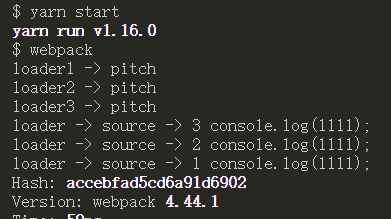
但是如果 pitchLoader 写了,并且有返回值,他会跳过后面的 loader 直接执行。
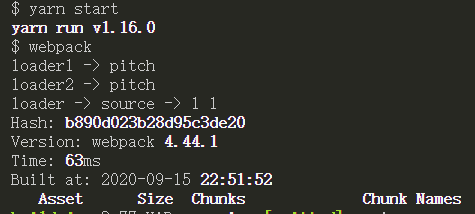
这段内容,先了解一下,具体需要参考代码调试查看结果
# loader 的特点
- 单一职责,一个
loader只做一件事情,正因为职责越单一,所以loader的组合性强,可配置性好。 loader支持链式调用,上一个loader的处理结果可以传给下一个loader接着处理,上一个loader的参数 options 可以传递给下一个 loader,直到最后一个 loader,返回 webpack 所期望的 js 代码- loader 是一个纯函数,不能有状态(外界的状态)
# 开发一个 loader
我们来实现一个比较常见的功能删除代码中所有 console 打印,我们使用 ast 来实现这个功能,整个过程我们分为以下几步:
- 新建一个 removeConsole.js 文件
- 在
astexplorer(opens new window) 中分析console语法树,找到console相关的特征 - 在代码中匹配到 console 语句,然后移除即可
最重要的阶段是分析语法树,我们是要分析 console 相关的执行语句,删除控制台中所有 console 的输出(log、error、warning 等),所以拿 console.log() 为例分析语法树,下图为 console.log() 解析后的语法树
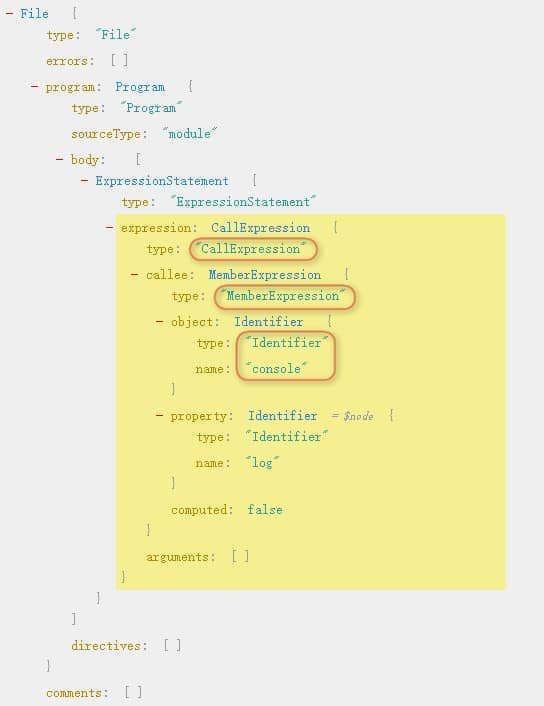
在语法树中我们发现 console.log() 是一个调用表达式 CallExpression,CallExpression 的 callee 是个成语表达式 MemberExpression,成语对象的标识符 Identifier 是 console,既然我们找到它了,那么在这个节点把它移除掉就可以。所以我们就可以按照写 ast 的那套流程在代码中这么写,最后把我们写好的这个 removeConsole loader 配置到 webpack 中就可以使用了
const babel = require('@babel/core');
const t = require('@babel/types');
function loader(source) {
const removeConsolePlugin = {
visitor: {
CallExpression(path) {
const { callee } = path.node;
if (t.isMemberExpression(callee) && t.isIdentifier(callee.object, { name: 'console' })) {
path.remove();
}
},
},
};
const ret = babel.transform(source, { plugins: [removeConsolePlugin] });
return ret.code;
}
module.exports = loader;
2
3
4
5
6
7
8
9
10
11
12
13
14
15
16
17
18
19
如果你还不熟悉 ast 的话,可以查看我之前写过一篇关于 ast 的文章 (opens new window)
# 异步写法
loader 也可以使用异步写法,只需要使用 this.async 来获取 callback 函数即可,我们使用异步的方式重新写一下 removeConsole 这个 loader ,这次使用正则替换内容
function loader(source) {
// 异步写法
const callback = this.async();
const consoleReg = /console\..+\(.+\)/g;
const result = source.replace(consoleReg, '');
callback(null, result);
}
module.exports = loader;
2
3
4
5
6
7
8
# loader 之间的关系
当我们编译
js的时候我们会用babel-loader和@babel/core最少两个依赖,编译less的时候,会用less-loader和less最少两个包,为什么呢?比如说
@babel/core和babel-loader的关系,@babel/core是核心编译babel-loader是把接受到的ctx传给@babel/core
// babel-loader 和 @babel/core 的关系
function babelLoader(ctx) {
return babelCore(ctx);
}
2
3
4
# loader-utils
loader 传递的参数可以在编写的 loader 的时候,使用 this.query 获取到传递过来的参数,但是都从 this.query 中获取可能会有点麻烦,所以 webpack 提供了一个库 loader-utils 专门处理 loader 的各种工具方法
使用 loader-utils 来处理 loader 参数的话,不管传递过来是字符串形式(?a=b)的还是对象形式的({a:b})参数都会给我们转成对象形式的参数,只需要使用他的 getOptions API 即可
模拟一个 babel-loader 的实现,传递参数 presets: ['@babel/preset-env'],babel-loader 的核心就是使用 babel 的核心转换源代码
// webpack.config.js
module.exports = {
module: {
rules: [
{
test: /\.js$/,
use: {
loader: 'babel-loader',
options: { presets: ['@babel/preset-env'] },
},
},
],
},
};
// babel-loader.js
const loaderUtils = require('loader-utils');
const babel = require('@babel/core');
function loader(source) {
// loader 传递过来的参数在 this 上可以获取到
// console.log(this.query);
const callback = this.async();
const options = loaderUtils.getOptions(this);
babel.transform(source, { ...options }, (err, result) => {
// 可以把 sourceMap 返回去,如果需要 sourceMap,需要设置 devtool为 'source-map',
callback(err, result.code, result.map);
});
}
module.exports = loader;
2
3
4
5
6
7
8
9
10
11
12
13
14
15
16
17
18
19
20
21
22
23
24
25
26
27
28
29
30
# 处理样式
loader 中样式处理常见的有 less-loader、css-loader、style-loader,less-loader 负责把 less 语法编译成 css 代码,style-loader 负责把 css 代码插入到 html 标签内,css-loader 处理的事情比较多,比如背景图的路径处理
他们实现也是蛮简单
// less-loader
const less = require('less');
function loader(source) {
const callback = this.async();
less.render(source, (err, result) => {
callback(err, result.css);
});
}
module.exports = loader;
// style-loader
function loader(source) {
const result = `
const style = document.createElement('style');
style.innerHTML = ${JSON.stringify(source)};
document.head.appendChild(style)
`;
return result;
}
module.exports = loader;
2
3
4
5
6
7
8
9
10
11
12
13
14
15
16
17
18
19
20
# 处理文件
一般我们使用 loader 来处理文本内容,loader 也是可以用来处理文件(二进制)。比如说 file-loader、url-loader 等,file-loader 作用就是劫持到引入的文件,然后生成新的文件到我们想要处理到的地方(比如 dist 目录),然后返回一个路径。
在项目中我们可以用会用到各种格式的文件,一些常见的文件我们可以使用各种 loader 来处理,但是不同的业务也可能会遇到其他特殊的文件没有对应的 loader 处理,此时我们可以使用 file-loader 来处理,file-loader 会把源文件拷贝一份到 dist 目录下,不会存在副作用。
例如 create-react-app 脚手架中的 webpack 配置,会把没有匹配到的文件使用 file-loader 来处理
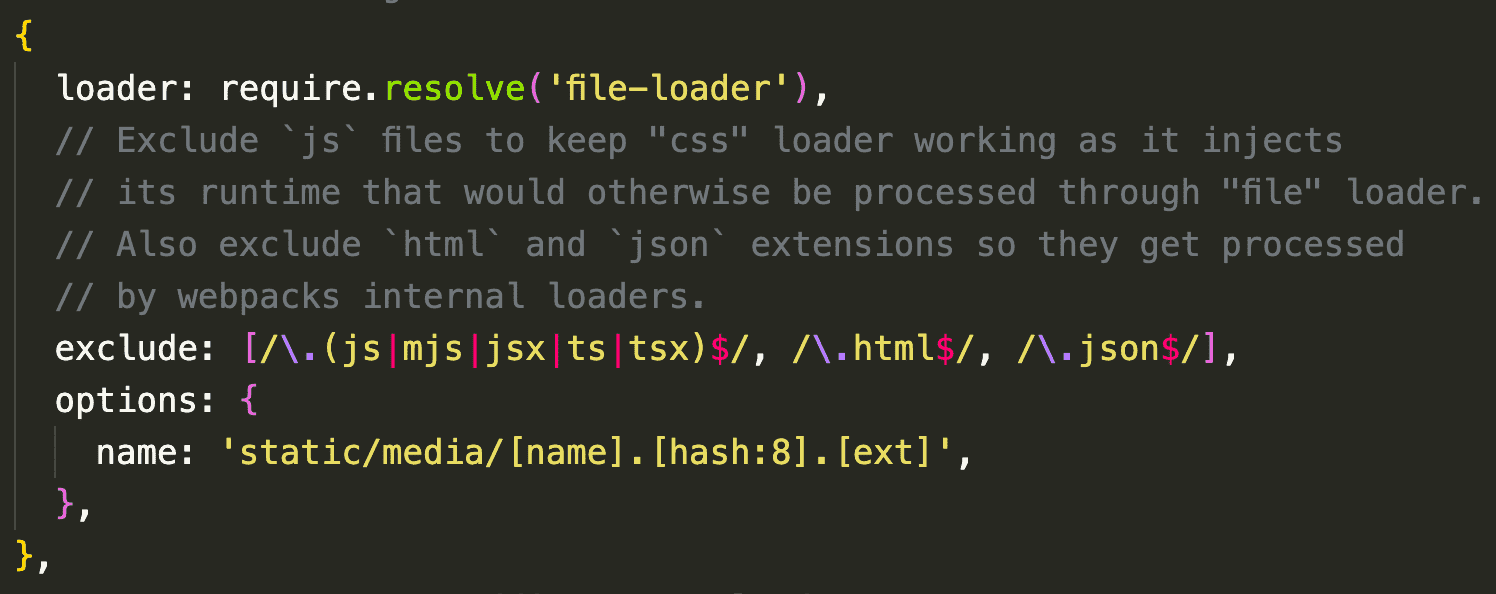
模拟一个 file-loader 的实现
在开发 loader 的时候接收的 source 参数默认会 toString 处理,处理文件或者二进制的时候我们就需要用到的是 buffer,不然就会乱码,此时需要告诉 loader 我们处理的文件内容是二进制
const loaderUtils = require('loader-utils');
function loader(content) {
console.log('loader -> content', content);
const fileUrl = loaderUtils.interpolateName(this, '[hash].[ext]', { content });
console.log('loader -> fileUrl', fileUrl);
// 把文件发射到dist目录下
this.emitFile(fileUrl, content);
return `module.exports="${fileUrl}"`;
}
loader.raw = true;
module.exports = loader;
2
3
4
5
6
7
8
9
10
11
12
此时引入图片,然后打包结果为

相应的 url-loader 是专门用来处理图片,比如对图片的做一下限制,文件内容小于多少的图片可以直接转 base64
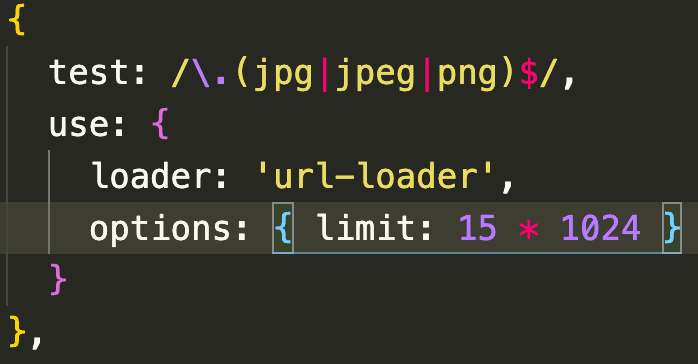
const loaderUtils = require('loader-utils');
const mime = require('mime');
function loader(source) {
const { limit } = loaderUtils.getOptions(this);
if (limit > source.length) {
// base64的格式:data:{文件格式};base64,{文件内容}
const base64 = `data:${mime.getType(this.resourcePath)};base64,${source.toString('base64')}`;
return `module.exports = "${base64}"`;
} else {
return require('./file-loader').call(this, source);
}
}
loader.raw = true;
module.exports = loader;
2
3
4
5
6
7
8
9
10
11
12
13
14
15
此时引入图片文件小于配置的 15kb,文件被打包为 base64

# webpack plugins
webpack 配置中的 plugins 是一个数组,接收一组的 plugin,每一个 plugin 是一个类,使用时需要 new 这个插件类。
插件目的在于解决 loader 无法实现的其他事,plugins 专注处理 webpack 编译过程中某个特定的任务的功能模块
webpack 打包是一个事件流机制,是将各个插件串联起来,核心是用了 tapable。并且在 webpack 中负责编译的 Compiler 和负责创建 bundles 的 Compilation 都是 tapable 构造函数的实例。
# tapable
tapable 类似于 node 中的 EventEmitter,但更专注于自定义事件的触发和处理。
webpack 通过 tapable 将实现与流程解耦,所有具体实现通过插件的形式存在。tapable 中主要提供了同步与异步两种钩子
const {
SyncHook,
SyncBailHook,
SyncWaterfallHook,
SyncLoopHook,
AsyncParallelHook,
AsyncParallelBailHook,
AsyncSeriesHook,
AsyncSeriesBailHook,
AsyncSeriesWaterfallHook,
} = require('tapable');
2
3
4
5
6
7
8
9
10
11
以最简单的 SyncHook 为例:
const { SyncHook } = require('tapable');
// 创建实例
const syncHook = new SyncHook(['name', 'age']);
// 注册事件
syncHook.tap('one', (name, age) => {
console.log('one', name, age);
});
syncHook.tap('two', (name, age) => {
console.log('two', name, age);
});
// 触发事件,让监听函数执行
syncHook.call('fecym', 25);
// one fecym 25
// two fecym 25
2
3
4
5
6
7
8
9
10
11
12
13
14
15
16
可以看到当我们执行 syncHook.call 时会依次执行前面 syncHook.tap 中的回调函数。通过 SyncHook 创建同步钩子,使用 tap 注册回调,再调用 call 来触发。这是 tapable 提供的多种钩子中比较简单的一种,通过 EventEmitter 也能轻松的实现这种效果。
其他同步钩子:
- SyncBailHook:类似于 SyncHook,执行过程中注册的回调返回非 undefined 时就停止不在执行。
- SyncWaterfallHook:接受至少一个参数,上一个注册的回调返回值会作为下一个注册的回调的参数。
- SyncLoopHook:有点类似 SyncBailHook,但是是在执行过程中回调返回非 undefined 时继续再次执行当前的回调。
tapable 中还有一些异步钩子,最基本的两个异步钩子分别是 AsyncParallelHook 和 AsyncSeriesHook。其他的异步钩子都是在这两个钩子的基础上添加了一些流程控制,类似于 SyncBailHook 之于 SyncHook 的关系。
具体了解 tapable 可以在下面的参考链接中具体查看
# Compiler 和 Compilation
在开发 plugin 时最常用的两个对象是 Compiler 和 Compilation。
Compiler 对象包含了webpack 环境所有的配置信息,如 options,loaders, plugins 这些项,该对象在 webpack 启动时候被实例化,它是全局唯一的。可以理解为 webpack 的实例。
Compilation 对象包含了当前的模块资源、编译生成资源、文件的变化等。当 webpack 在开发模式下运行时,每当检测到一个文件发生改变的时候,那么一次新的 Compilation 将会被创建。从而生成一组新的编译资源。
Compiler 对象的事件钩子以及作用
| 勾子 | 参数 | 作用 | 类型 |
|---|---|---|---|
| after-plugins | 设置完一组初始化插件之后 | compiler | sync |
| after-resolvers | 设置完 resolvers 之后 | compiler | sync |
| run | 在读取记录之前 | compiler | async |
| compile | 在创建新 compilation 之前 | compilationParams | sync |
| compilation | compilation 创建完成 | compilation | sync |
| emit | 在生成资源并输出到目录之前 | compilation | async |
| after-emit | 在生成资源并输出到目录之后 | compilation | async |
| done | 完成编译 | stats | sync |
下面我们通过具体的案例了解一下 Compiler 和 Compilation 的使用。
# 实现一个资源分析插件
实现一个资源分析插件:在打包完成之后,统计所有打包后资源的大小
在 webpack 中使用插件的时候需要 new 这个插件,那么这个插件一定是个类(构造函数)。webpack 执行时,先生成插件的实例对象,之后会调用插件上的 apply 方法,并将 compiler 对象作为参数传递给 apply。因此这个构造函数有个核心的 apply 方法
我们要做一个资源分析的插件,所以是在生成资源后输出到目录之前注册一个事件,这个事件函数接收一个 compilation 对象,compilation.assets 是我们所有的资源文件对象,每一个对象里面都有 source 和 size 方法,我们可以这里面控制输出的资源
class AssetsAnalysePlugin {
constructor({ filename = 'analyse.md' }) {
// 接收传递过来的参数
this.filename = filename;
}
apply(compiler) {
// 因为我们要统计打包后资源的大小,所以在生成资源后输出到目录之前注册事件
compiler.hooks.emit.tap('AssetsAnalysePlugin', compilation => {
const assets = compilation.assets;
// 字符串拼接大法
let content = `# 资源统计 \r\n\r\n| 资源名称 | 资源大小 |\r\n| ------ | ------ |`;
let size = 0;
const assetsEntries = Object.entries(assets);
assetsEntries.forEach(([filename, fileObj]) => {
content += `\r\n| ${filename} | ${fileObj.size()} b |`;
size += fileObj.size();
});
content += `\r\n\r\n共有 ${assetsEntries.length} 个资源,共 ${(size / 1024).toFixed(2)} kb`;
assets[this.filename] = {
source() {
return content;
},
size() {
return content.length;
},
};
});
}
}
module.exports = AssetsAnalysePlugin;
2
3
4
5
6
7
8
9
10
11
12
13
14
15
16
17
18
19
20
21
22
23
24
25
26
27
28
29
30
31
用法
module.exports = {
// ... 其他配置
plugins: [
new MiniCssExtractPlugin({ filename: 'css/[name].[hash:6].css' }),
new HtmlWebpackPlugin({
template: path.resolve('./public/index.html'),
filename: 'index.html',
}),
// 使用我们的插件
new AssetsAnalysePlugin({ filename: 'analyse.md' }),
],
};
2
3
4
5
6
7
8
9
10
11
12
# 实现一个静态资源替换插件
再来资源替换插件,熟悉一下 plugin 的开发。把打包后的静态资源替换成我们的 cdn 地址,或者服务器上的绝对地址
// 需求:把所有的引入中的静态资源 static 变成 https://chengyuming.cn/
const fs = require('fs');
class StaticAssetsPlugin {
constructor({ isProd = true, outputPath = 'dist', staticPath = 'static', cdnAddr = '/' }) {
this.isProd = isProd;
this.outputPath = outputPath;
this.staticPath = staticPath;
this.cdnAddr = cdnAddr;
}
apply(compiler) {
if (!this.isProd) return;
compiler.hooks.done.tapAsync('StaticAssetsPlugin', compilation => {
const outputPath = compiler.options.context + '/' + this.outputPath;
const assets = compilation.toJson().assets;
const staticPathReg = new RegExp('([../]+)/' + this.staticPath + '/', 'g');
assets.forEach(fileObj => {
const filePath = outputPath + '/' + fileObj.name;
console.log('apply -> filePath', filePath);
fs.readFile(filePath, (err, res) => {
if (err) throw err;
let result = res.toString();
result = result.replace(staticPathReg, this.cdnAddr);
fs.writeFileSync(filePath, result);
});
});
});
}
}
module.exports = StaticAssetsPlugin;
2
3
4
5
6
7
8
9
10
11
12
13
14
15
16
17
18
19
20
21
22
23
24
25
26
27
28
29
30
// webpack.config.js
const StaticAssetsPlugin = require('./plugins/StaticAssetsPlugin');
module.exports = function(env, argv) {
return {
// ... 其他配置
plugins: [
new StaticAssetsPlugin({
isProd: true,
outputPath: 'dist',
staticPath: 'static',
cdnAddr: 'https://chengyuming.cn/',
}),
],
};
};
2
3
4
5
6
7
8
9
10
11
12
13
14
15
// 测试
const webpackContext = require.context('../static/imgs/', false, /\.(jpg|jpeg|png)$/);
const requireAll = ctx => ctx.keys().map(ctx);
const imgs = requireAll(webpackContext).map(r => r.default);
const fragment = document.createDocumentFragment();
imgs.forEach(item => {
const img = new Image();
img.src = `<img src="../static/${item}">`;
fragment.appendChild(img);
});
document.getElementById('root').appendChild(fragment);
2
3
4
5
6
7
8
9
10
11
12
13
14
# 两个插件的结果
最终使用两个插件的结果如下:
StaticAssetsPlugin 的结果
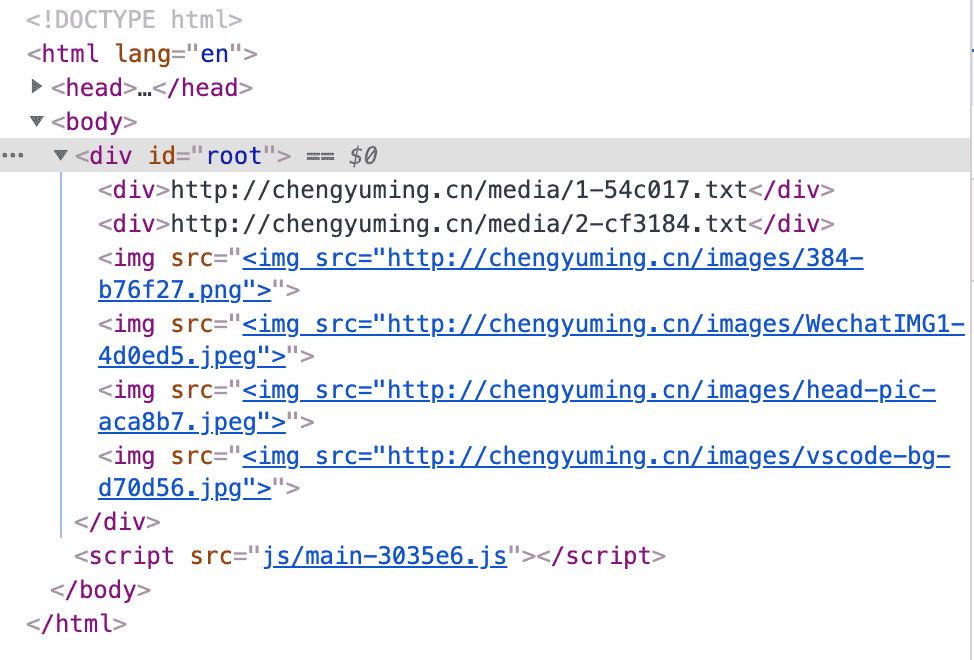
AssetsAnalysePlugin 的结果
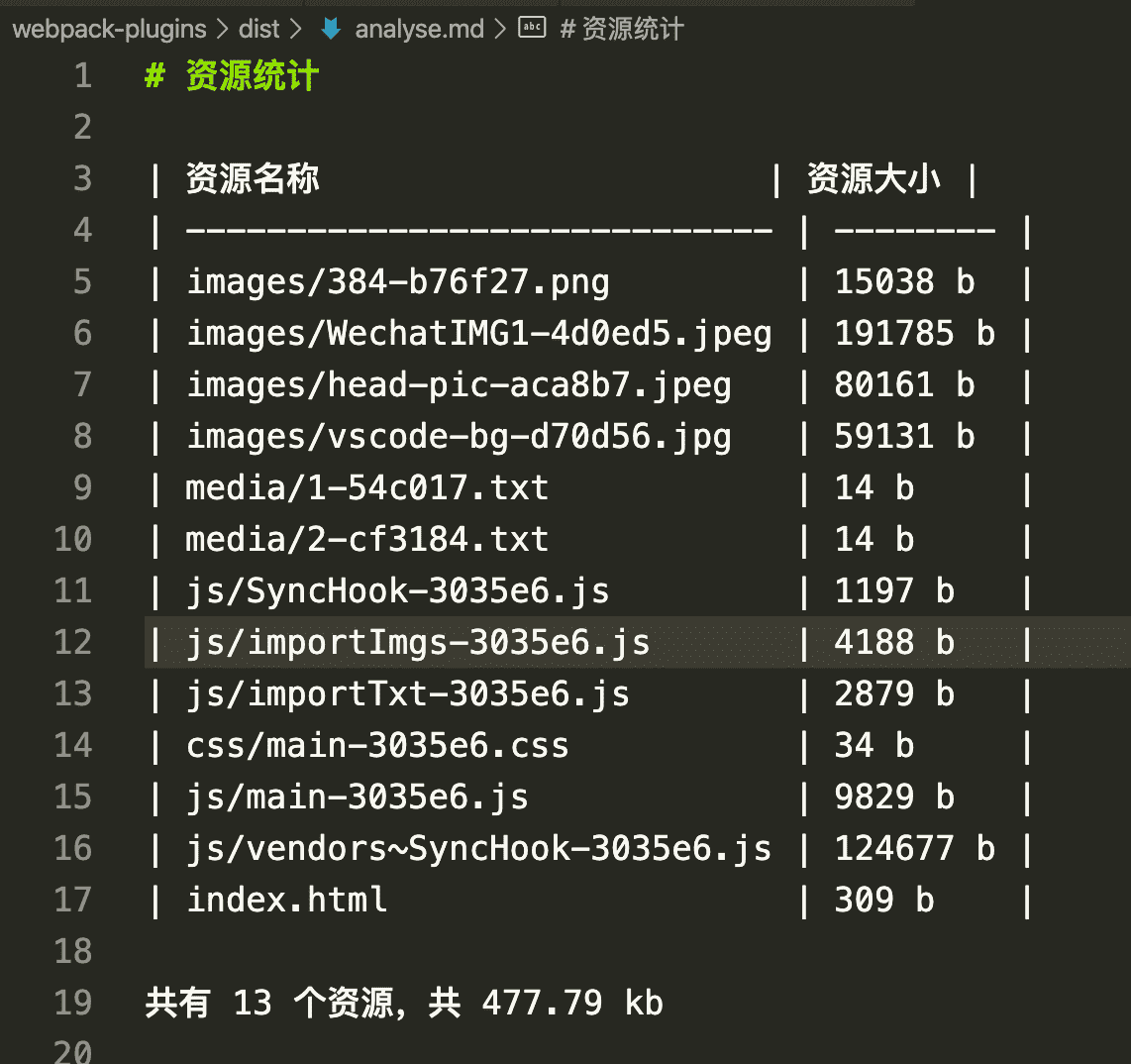
webpack 的 plugin 功能很强大,当然学习成本比较大,当你熟悉之后可以根据业务来实现各种你想要的功能
# 源码地址
代码已存放到 github,地址 (opens new window)
